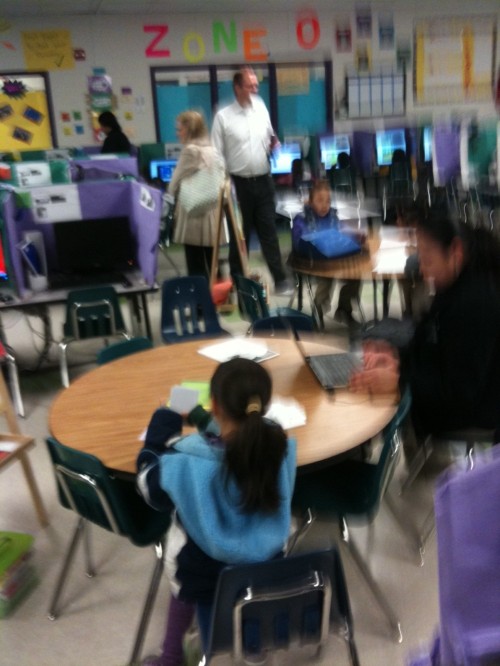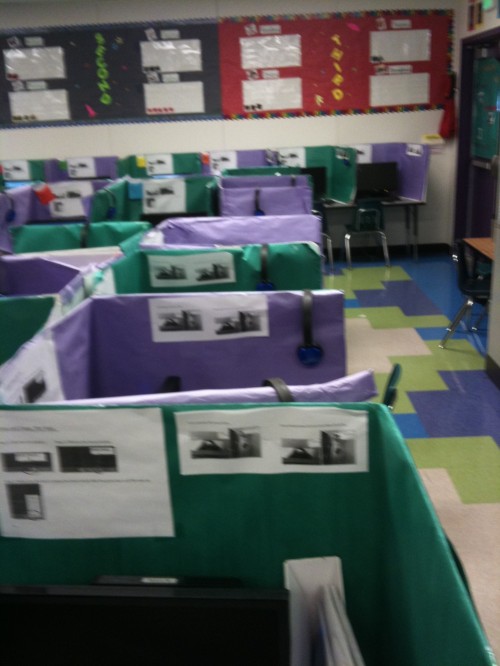“I Saw The Future and It Works”: A Visit to a Hybrid School
The quote in the title ran through my mind as I spent a morning in the Learning Lab and one classroom at a hybrid elementary school (K-5) in San Jose (CA). With about 500 mostly Latino and low-income students chosen through a lottery, Los Suenos is a Rocketship charter school, in a rapidly expanding network of hybrid schools in California and across the nation.
With an extended school day beginning 7:55AM and ending at 4:00, a staff of 16 certificated teachers, 8 Learning Lab specialists, and parents who are expected to volunteer 30 hours during the school year work, a band of adults work closely with kindergartners through 5th graders. Each child has an individual education plan. Nearly all of the teachers are drawn from Teach for America; none looked over 40. They make home visits and are available before and after school to both students and parents.
Much has been written about elementary schools that combine online learning for part of the school day with teachers in regular classrooms teaching lessons. See here, here, and here. I wanted to see a hybrid in action. Before unpacking the above quote, however, I want to report what I saw that morning.
All through the day on a rotating schedule, kindergartners and upper-grade students move through the Learning Lab which can accommodate up to 80 students. Each class is there for one quarter of the school day.
In these brightly-colored cardboard cubicles, each student has a computer and mouse.
Kindergartners through 5th graders find their name on the screen, login, and begin the reading or math program. Eight Learning Lab Specialists roam the large room. College students and parents in the community, the aides monitor what children are doing in their math or reading program, answer questions, and intervene when students’ attention fades or they are off-task. When students finish a lesson and pass the accompanying test, they raise their hands and an aide gives them a sticker which appears to be highly prized.
There are also round tables in the room where Learning Lab Specialists tutor small groups in either math or reading skills for short periods of time.
After the Learning Lab, students line up and aides take them to their classrooms (for information on Rocketship’s mission, staffing, and schedule see Rocketship Overview).
I visited a 2nd grade classroom where 28 children were sitting in a half-circle on the floor. Their energetic, enthusiastic teacher (a second-year Teach for America recruit) asked the children to answer the question whether immigration to the U.S. was good or bad. This question launched a project that student teams were to find answers to that question. The teacher was going over the different activities that each team would work on in their project. She had Bloom’s taxonomy on a chart next to her listing a hierarchy of cognitive skills. The taxonomy was like a ladder going from the bottom rung of remembering facts to the top one of using critical thinking when making judgments. The 7 year-olds knew from previous lessons each of the rungs on the ladder.
I watched as the teacher read from a slip of paper describing an activity (e.g., pick a way to solve the immigration problem) and then ask the children to talk to their team-mates and decide in which cognitive domain on the chart before them the activity should be put. After a few moments of students talking to one another, she asked group members where she should stick the slip of paper. Students waved their arms to be called upon each time. After each domain had an activity pasted on it, she then asked the children to form into their preassigned groups and discuss how they would begin their project. The teacher had assigned roles for each student to perform in their small group (e.g., leader, time-keeper) with different colored dots at their desks. The students went into groups and began discussing their project.
What I saw in this lesson was a novice teachers engaged in ambitious teaching with 7 year-olds. How much the students understood of Bloom’s Taxonomy to apply it to the project they were working on and answer the overall question on immigration, I have no idea. What I saw was 28 students wanted to please their teacher and engaged in the part of the lesson I watched.
I left the classroom and went to meet with John Danner, CEO of Rocketship schools. Danner had started a software company and, after a few years, sold it when he was in his early 30s. He then became a teacher for a few years before he and a former Teach for America graduate came up with the idea of Rocketship. The next post describes the interview and unpacks exactly for whom the quote “I Saw the Future and It Works” applies.
This blog post has been shared by permission from the author.
Readers wishing to comment on the content are encouraged to do so via the link to the original post.
Find the original post here:
The views expressed by the blogger are not necessarily those of NEPC.

